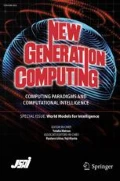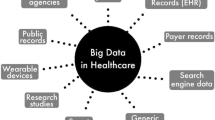Abstract
In this article, I describe the basic technologies for Semantic Web and relationship between Semantic Web and Knowledge Representation in Artificial Intelligence. Semantic Web is planned as an extension of the current web in order to help cooperation between computers and humans, i.e., computers and humans are expected to understand each other in the knowledge level. I first describe the vision of the Semantic Web, then introduce the current Semantic Web technologies, i.e., RDF, RDFS, and OWL. I describe relationship between the trend of Semantic Web and Knowledge Representation, and clarify challenges and difficulties of Semantic Web from the point of view of Knowledge Representation.
Similar content being viewed by others
References
Berners-Lee, T., Hendler, J. and Lassila, O., “The Semantic Web,”Scientific American, May 2001.
Berners-Lee, T., “Semantic Web.” Keynote Speech,XML 2000, 2000, http://www.w3.org/2000/Talks/1206-xml2k-tbl/
Lassila, O., “Web Metadata: A Matter of Semantics,”IEEE Internet Computing, 2, 4, pp. 30–37, 1998.
Berners-Lee, T., Fielding, R. and Masinter, L., “RFC 2396 — Uniform Resource Identifiers (URI): Generic Syntax,”tech. rep., IETF, 1998.
Berners-Lee, T. and Connolly, D., “Primer: Getting into RDF & Semantic Web using N3,” http://www.w3.org/2000/10/swap/Primer.html
Brickley, D. and Guha, R., “RDF Vocabulary Description Language 1.0: RDF Schema,”W3C Recommendation 10 Feb. 2004, http://www.w3.org/TR/rdfschema/
McGuinness, D. L. and Harmelen, F. van, “OWL Web Ontology Language Overview,”W3C Recommendation 10 Feb. 2004, http://www.w3.org/TR/owlfeatures/
Connolly, D., Harmelen, F. van Horrocks, I. McGuinness, D. L., Patel-Schneider, P. F. and Stein, L. A., “DAML+OIL (March 2001) Reference Description,”W3C Note 18 Dec. 2001, http://www.w3.org/TR/daml+oil-reference
Horrocks, I., “DAML+OIL: a description logic for the semantic web,”IEEE Data Engineering Bulletin, 25, 1, pp. 4–9, 2002.
Fensel, D., Harmelen, F. van, Horrocks, I., McGuinness, D. and Patel-Schneider, P., “Oil: An Ontology Infrastructure for the Semantic Web,”Intelligent Systems, 16, 2, pp. 38–44, 2001.
Baader, F., Calvanese, D., McGuinness, D. Nardi, D. and Patel-Schneider, P. (eds.),The Description Logic Handbook: Theory, Implementation and Applications, Cambridge University Press, 2003.
Dean, M. and Schreiber, G., “OWL Web Ontology Language Reference,”W3C Recommendation 10 Feb. 2004, http://www.w3.org/TR/owl-ref/
Golbeck, J., Parsia, B. and Hendler, J., “Trust networks on the semantic web,” inProc. of Cooperative Intelligent Agents 2003, Helsinki, Finland, Aug. 2003.
Adamic, L. A., Buyukkokten, O. and Adar, E., “A Social Network Caught in the Web,”First Monday, 8, 6, 2003.
Ohmukai, I., Numa, K. and Takeda, H., “Egocentric Search Method for Authoring Support in Semantic Weblog,”Workshop on Knowledge Markup and Semantic Annotation (Semannot2003), Held in conjunction with the Second Intern. Conf. on Knowledge Capture (K-CAP2003), 2003.
Lenat, D. B. and Guha, R. V.,Building Large Knowledge-Based Systems: Representation and Inference in the Cyc Project, Addison-Wesley Longman Publishing Co., Inc., 1989.
Yokoi, T., “The EDR Electronic Dictionary,”Communications of ACM, 38, 11, pp. 42–44, 1995.
Manoda, F. and Miller, E., “RDF Primer,”W3C Recommendation, 10 Feb. 2004, http://www.w3.org/TR/rdf-primer/
Smith, M. K., Weltyand, C. and McGuinness, D. L., “OWL Web Ontology Language Guide,”W3C Recommendation, 10 Feb. 2004, http://www.w3.org/TR/owlguide/
Klein, M. C. A., Broekstra, J., Fensel, D. Hermelen, F. van and Horrocks, I., “Ontologies and Schema Languages on the Web,” inSpinning the Semantic Web (D. Fensel, J. A. Hendler, H. Lieberman, and W. Wahlster, eds.), pp. 95–139, MIT Press, 2003.
Broekstra, J., Klein, M. C. A., Decker, S., Fensel, D., Harmelen, F. van and Horrocks, I., “Enabling Knowledge Representation on the Web by Extending RDF Schema,”Computer Networks, 39, 5, pp. 609–634, 2002.
Horrocks, I. and Hendler, J. (eds.), “The Semantic Web — ISWC 2002,” ofLecture Notes in Computer Science, 2342, Springer, 2002.
Fensel, D., Sycara, K. and Mylopoulos, J. (eds.), “The Semantic Web — ISWC 2003,” ofLecture Notes in Computer Science, 2870, Springer, 2003.
Author information
Authors and Affiliations
Additional information
Hideaki Takeda: He is a professor at National Institute of Informatics (NII) and a professor in Department of Informatics at the Graduate University of Advanced Studies (Sokendai). He received his Ph.D. from the University of Tokyo in 1991. His research interest in computer science includes ontology engineering, community informatics and knowledge sharing systems.
About this article
Cite this article
Takeda, H. Semantic Web: A road to the knowledge infrastructure on the internet. New Gener Comput 22, 395–413 (2004). https://doi.org/10.1007/BF03037289
Received:
Revised:
Issue Date:
DOI: https://doi.org/10.1007/BF03037289




